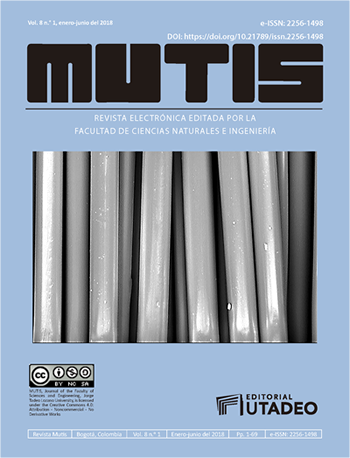Esta obra está bajo una licencia internacional Creative Commons Atribución-NoComercial-CompartirIgual 4.0.
Resumen
Los colorantes azo son considerados compuestos peligrosos para el medio ambiente y la salud humana. Uno de estos compuestos es el naranja de metilo el cual ha sido ampliamente utilizado en industrias textiles, de cuero y otras industrias químicas. La degradación de este compuesto se ha convertido en un reto mediante tratamientos convencionales. Algunos procesos de oxidación avanzada como la fotocatálisis heterogénea, la sonólisis, la radiólisis, etc., constituyen una alternativa para la mineralización de compuestos orgánicos gracias a la generación in-situ de un radical altamente oxidante (OH•). En la actualidad, un gran número de investigaciones han tratado de modificar el TiO2 con metales para mejorar la degradación de contaminantes peligrosos como los colorantes azo. En este estudio se utilizó arena negra como una alternativa de fotocatalizador para evaluar el efecto del pH (2.0, 5.8 y 8.0) y la temperatura (20, 25, 30 y 35 °C) en el proceso de oxidación fotocatalítica del naranja de metilo. Debido a las características del mineral, se aplicaron diferentes campos magnéticos para obtener fracciones que fueron utilizadas como semiconductor, de las cuales se utilizó la que exhibió mejores condiciones para la degradación del colorante. Los resultados experimentales permitieron determinar que la oxidación fotocatalítica de naranja de metilo presentó una mayor eficiencia con un pH 2.0 y a 30° C, con un porcentaje de degradación de 96.93 %. La reacción observada describió una cinética de pseudo primer orden y mediante la ecuación de Arrhenius se determinó el coeficiente cinético a diferentes temperaturas. El coeficiente pre exponencial de la ecuación fue de 374782115.1 y la energía de activación fue de -58104.4 J mol-1 K-1.
Citas
Arshadi, M., Abdolmaleki, M. K., Mousavinia, F., Khalafi-Nezhad, A., Firouzabadi, H., & Gil, A. (2016). Degradation of methyl orange by heterogeneous Fenton-like oxidation on a nano-organometallic compound in the presence of multi-walled carbon nanotubes. Chemical Engineering Research and Design, 112(Supplement C), 113-121. doi:10.1016/j.cherd.2016.05.028.
Chen, L. C., Tsai, F. R., & Huang, C. M. (2005). Photocatalytic decolorization of methyl orange in aqueous medium of TiO2 and Ag–TiO2 immobilized on γ-Al2O3. Journal of Photochemistry and Photobiology A: Chemistry, 170(1), 7-14. doi:10.1016/j.jphotochem.2004.07.012.
Cheng, X. Q., Ma, C. Y., Yi, X. Y., Yuan, F., Xie, Y., Hu, J. M., … & Zhang, Q. Y. (2016). Structural, morphological, optical and photocatalytic properties of Gd-doped TiO2 films. Thin Solid Films, 615(Supplement C), 13-18. doi:10.1016/j.tsf.2016.06.049.
Dagar, A., & Narula, A. K. (2016). Photo-degradation of methyl orange under visible light by PEDOT/NiO/Fly ash cenosphere. Materials Chemistry and Physics, 183(Supplement C), 561-570. doi:10.1016/j.matchemphys.2016.09.015.
Dahm, C., & L. Brezonik, P. (1995). Chemical Kinetics and Process Dynamics in Aquatic Systems. Journal of the North American Benthological Society, 14, 354.
Feng, C., Liu, L., Li, F., & Li, X. (2009). Microbial fuel cell with an azo-dye-feeding cathode. Applied Microbiology and Biotechnology, 85, 175-183.
Figueroa, S., Vázquez, L., & Alvarez-Gallegos, A. (2009). Decolorizing textile wastewater with Fenton’s reagent electrogenerated with a solar photovoltaic cell. Water Research, 43(2), 283-294. doi:10.1016/j.watres.2008.10.014.
Gao, Y., Yang, M., Hu, J., & Zhang, Y. (2004). Fenton’s process for simultaneous removal of TOC and Fe2+ from acidic waste liquor. Desalination, 160, 123-130.
Hai, F. I., Yamamoto, K., Nakajima, F., & Fukushi, K. (2011). Bioaugmented membrane bioreactor (MBR) with a GAC-packed zone for high rate textile wastewater treatment. Water Research, 45(6), 2199-2206. doi:10.1016/j.watres.2011.01.013.
He, H., Zhong, Y., Liang, X., Tan, W., Zhu, J., & Wang, C. Y. (n.d.). Natural Magnetite : an efficient catalyst for the degradation of organic contaminant. Nature Publishing Group, 1-10.
Herney-Ramirez, J., Vicente, M. A., & Madeira, L. M. (2010). Heterogeneous photo-Fenton oxidation with pillared clay-based catalysts for wastewater treatment: A review. Applied Catalysis B: Environmental, 98(1), 10-26. doi:10.1016/j.apcatb.2010.05.004.
Iliev, V., Tomova, D., Todorovska, R., Oliver, D., Petrov, L., Todorovsky, D., & Uzunova-Bujnova, M. (2006). Photocatalytic properties of TiO2 modified with gold nanoparticles in the degradation of oxalic acid in aqueous solution. Applied Catalysis A: General, 313(2), 115-121. doi:10.1016/j.apcata.2006.06.039.
Lee, H. J., Kim, J. H., Park, S. S., Hong, S. S., & Lee, G. D. (2015). Degradation kinetics for photocatalytic reaction of methyl orange over Al-doped ZnO nanoparticles. Journal of Industrial and Engineering Chemistry, 25(Supplement C), 199-206. doi:10.1016/j.jiec.2014.10.035.
Li, Y., Li, X., Li, J., & Yin, J. (2006). Photocatalytic degradation of methyl orange by TiO2-coated activated carbon and kinetic study. Water Research, 40(6), 1119-1126. doi:10.1016/j.watres.2005.12.042.
Lien, H. L., & Zhang, W. X. (2007). Nanoscale Pd/Fe bimetallic particles: Catalytic effects of palladium on hydrodechlorination. Applied Catalysis B: Environmental, 77(1), 110-116. doi:10.1016/j.apcatb.2007.07.014.
Martínez-Huitle, C. A., & Brillas, E. (2009). Decontamination of wastewaters containing synthetic organic dyes by electrochemical methods: A general review. Applied Catalysis B: Environmental, 87(3), 105-145. doi:10.1016/j.apcatb.2008.09.017.
Matos, J., Laine, J., & Herrmann, J. M. (2001). Effect of the Type of Activated Carbons on the Photocatalytic Degradation of Aqueous Organic Pollutants by UV-Irradiated Titania. Journal of Catalysis, 200(1), 10-20. doi:10.1006/jcat.2001.3191.
Matouq, M., Al-Anber, Z., Susumu, N., Tagawa, T., & Karapanagioti, H. (2014). The kinetic of dyes degradation resulted from food industry in wastewater using high frequency of ultrasound. Separation and Purification Technology, 135(Supplement C), 42-47. doi: 10.1016/j.seppur.2014.08.002
Muda, K., Aris, A., Salim, M. R., Ibrahim, Z., Yahya, A., van-Loosdrecht, M. C. M., … & Nawahwi, M. Z. (2010). Development of granular sludge for textile wastewater treatment. Water Research, 44(15), 4341-4350. doi:10.1016/j.watres.2010.05.023.
Oros-Ruiz, S., Gómez, R., López, R., Hernández-Gordillo, A., Pedraza-Avella, J. A., Moctezuma, E., & Pérez, E. (2012). Photocatalytic reduction of methyl orange on Au/TiO2 semiconductors. Catalysis Communications, 21(Supplement C), 72-76. doi:10.1016/j.catcom.2012.01.028.
Reyes Gomez, G.A. (2015). Producción fotocatalítica de hidrógeno basada en el mineral arena negra, Universidad Libre sede Principal, https://repository.unilibre.edu.co/handle/10901/9974?show=full.
Sahel, K., Elsellami, L., Mirali, I., Dappozze, F., Bouhent, M., & Guillard, C. (2016). Hydrogen peroxide and photocatalysis. Applied Catalysis B: Environmental, 188(Supplement C), 106-112. doi:10.1016/j.apcatb.2015.12.044.
Schoonen, M. A. A., Xu, Y., & Strongin, D. R. (1998). An introduction to geocatalysis. Journal of Geochemical Exploration, 62(1), 201-215. doi:10.1016/S0375-6742(97)00069-1.
Sonawane, R. S., & Dongare, M. K. (2006). Sol-gel synthesis of Au/TiO2 thin films for photocatalytic degradation of phenol in sunlight. Journal of Molecular Catalysis A: Chemical, 243(1), 68-76. doi:10.1016/j.molcata.2005.07.043.
Subbaiah, M. V., & Kim, D. S. (2016). Adsorption of methyl orange from aqueous solution by aminated pumpkin seed powder: Kinetics, isotherms, and thermodynamic studies. Ecotoxicology and Environmental Safety, 128(Supplement C), 109-117. doi:10.1016/j.ecoenv.2016.02.016.
Vargas, J. A., & Forero, A. H. (2011). Obtención de hierro a partir de arenas negras del Atlántico colombiano. Desembocadura río Magdalena. Revista de la Facultad de Ingeniería, 26, 19-26.
Wang, E., Zheng, Q., Xu, S., & Li, D. (2011). Treatment of Methyl Orange by Photocatalysis Floating Bed. Procedia Environmental Sciences, 10(Part B), 1136-1140. doi:10.1016/j.proenv.2011.09.181.
Yan, J., Zhu, Y., Qiu, F., Zhao, H., Yang, D., Wang, J., & Wen, W. (2016). Kinetic, isotherm and thermodynamic studies for removal of methyl orange using a novel β-cyclodextrin functionalized graphene oxide-isophorone diisocyanate composites. Chemical Engineering Research and Design, 106(Supplement C), 168-177. doi:10.1016/j.cherd.2015.12.023
Descargas
Datos de publicación
Perfil evaluadores/as N/D
Declaraciones de autoría
- Sociedad académica
- Universidad de Bogotá Jorge Tadeo Lozano
- Editorial
- Universidad de Bogotá Jorge Tadeo Lozano

 PDF (English)
PDF (English)
 FLIP
FLIP













